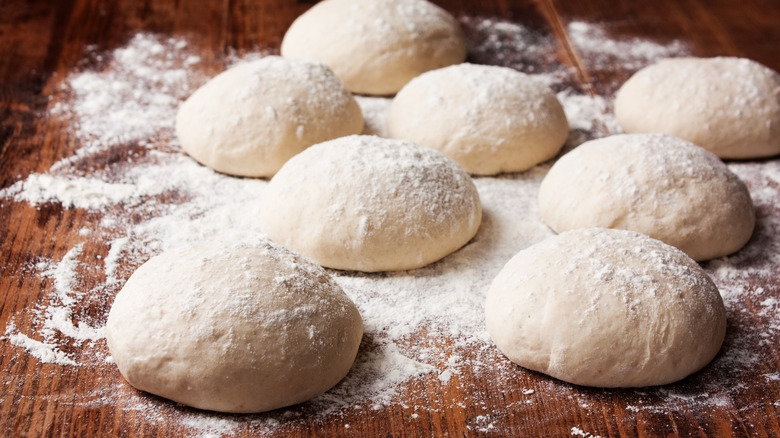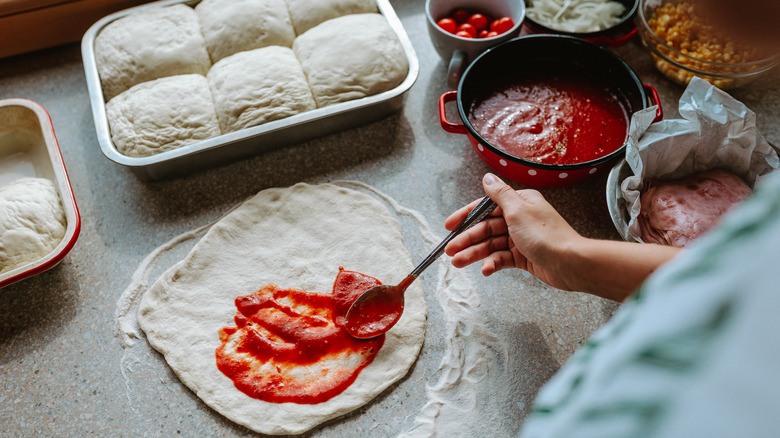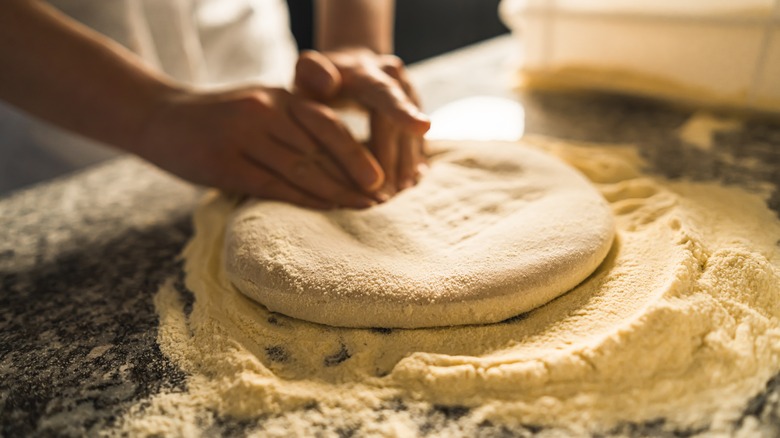Can You Freeze Leftover Pizza Dough?
Once you've developed a taste for homemade pizza with dough made from scratch, it's darn near impossible to find the same satisfaction in store-bought alternatives. The freedom to choose the ingredients (when else can you add champagne to your pizza dough?) and the deliciousness of the freshly-baked crust is hard to beat. The only downside is that making dough can be time-consuming, so you won't want to throw out any leftovers. Luckily, you can freeze pizza dough and save it for another day — it can stay fresh for up to three months, in fact.
After you knead the dough and let it rise, you have a few options for freezing it. One way is to divide the dough into smaller single-portion balls, line them up on a tray, and freeze. Transfer the balls into a zip-top bag, then return them to the freezer. Consider brushing each ball in a light layer of oil or cooking spray after that initial freeze, as this will keep them from sticking to each other or to the bag. This will also minimize the chances of freezer burn — those discolored spots and ice crystals that will alter their taste and texture for the worse.
There's also the option of rolling each ball flat and freezing them that way, so they're ready to be dressed up and baked quicker. You can even pre-bake it before storing, or load it with sauce and toppings beforehand, store-bought frozen pizza style.
More ways to ensure pizza dough freezes well
While freezing leftovers is a great idea, it's even better to decide in advance if you want to freeze your pizza dough. This will allow you to tweak your recipe specifically for freezing. For starters, yeast doesn't fare well in cold temperatures once activated. Always add 50% more yeast to the dough if you plan to freeze it, so you still get that crisp yet tender crust when it is baked.
You'll also want to consider the type of flour. High protein flours (such as bread flour) develop more sturdy gluten when kneaded, which helps the dough hold its structure much better after freezing, compared to low-protein choices like all-purpose flour. Choosing the wrong flour is a mistake everyone makes with their homemade pizza dough, so try to get it right.
Once the dough is ready to go, make sure that you only use plastic wraps or bags for freezing. Never place the dough on parchment or wax paper, as it will stubbornly stick to it. Regardless of the precautions you take, though, the dough's quality will change over time. The gluten present inside will weaken in the cold depths of the freezer, yielding a dough that's harder to stretch and shape evenly. Since cold storage also affects the dough's ability to rise, try to use it up within a month or so, even though it will remain usable for a bit longer.
How to thaw the dough when it's pizza time
To thaw balls of frozen dough before making a pizza, ideally, you'll exercise some patience: The slower the dough thaws, the closer it will be to the fresh stuff. To take the longer route, transfer the dough balls to the refrigerator at least 12 hours before you want to make your pies. Make sure to transfer the dough to a container with plenty of empty room, as it will ferment and expand while it thaws.
You can also soak the bag of frozen dough in a bowl of cold water to shorten the thawing time to an hour or two. Alternatively, there's an even quicker way if you want fresh pizzas out of frozen dough pronto: Pop it in the microwave for one and a half minutes, using the defrost setting, if your appliance has one. Let the dough rest for two minutes before you turn it over and microwave it for another minute.
No matter which method you use, give the dough another 30 minute rest at room temperature once it has thawed. This will make it more pliable for stretching and shaping. If you find that your dough is warmer and stickier than you want it to, use generous amounts of semolina flour on your hands and workspace. On the flip side, keep working it with your hands if it's still too cold to the touch — it'll form a great pizza base in no time.



